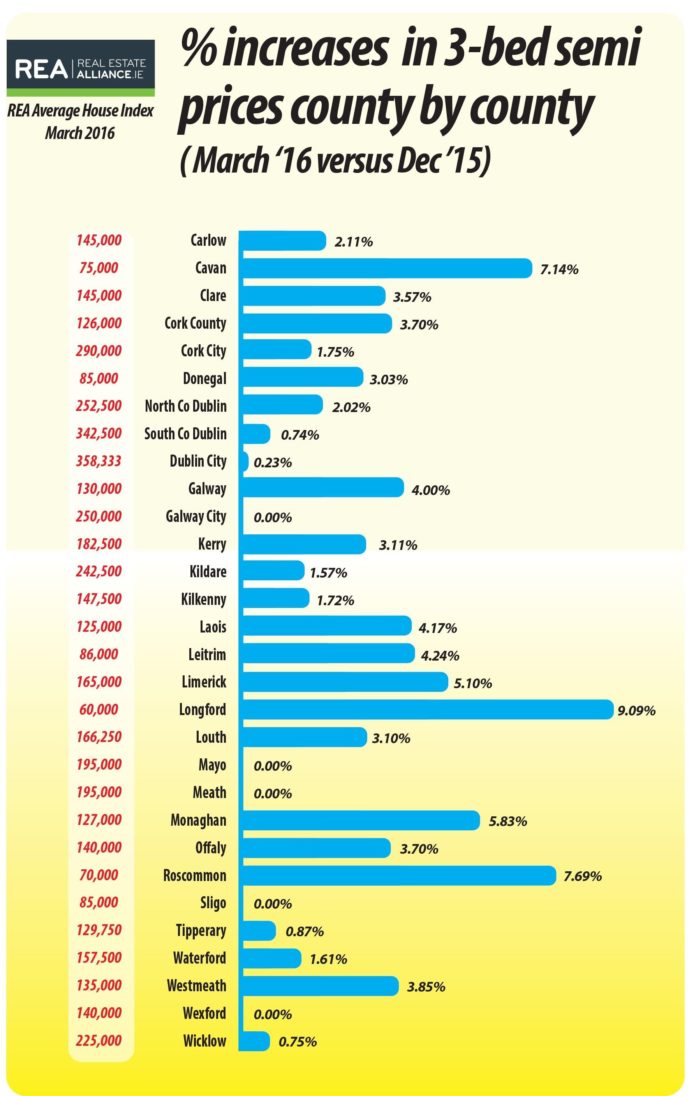
The price of the average three-bed semi detached house in Cork city has increased by 1.75% to €290,000 in the first three months of 2016, a nationwide property survey has found.
The REA Average House Price Survey concentrates on the sale price of Ireland’s typical stock home, the three-bed semi, giving an up-to-date picture of the property market in towns and cities countrywide to the end of Q1 this week.
The average house in the city takes just three weeks to sell, with 60% of purchases completed by cash buyers. Meanwhile, the average three-bed semi in Cork county has increased 3.7% to €126,000.
According to Michael O’Donoghue from REA O’Donoghue Clarke in Cork city, there is strong demand but limited supply in mature areas and popular residential areas.
“We see a steady increase in values but the Central Bank lending rules are having an increasingly detrimental impact on the market, in particular the 20% deposit requirement over €220,000. This is leading to little or no building and effecting first-time buyers with knock-on affects in the rental market.”
The average three-bed semi nationally now costs €191,194, a rise of €2,824 or 1.5% on Q4 2015.
The average price of a three-bed semi in Dublin City and County has risen by 0.6% from €332,000 to €334,000 in the first three months of the year.
However, this activity is mainly centered on limited new building activity in the north of the county and pockets of south Dublin which have seen the return of the cash buyer to the market.
While prices have risen slightly by €2,706 (+1.31%) to €209,559 in the commuter counties and main cities such as Cork and Galway, these rises are confined to the few towns that have new developments on the market.
The biggest growth has been in towns in the rest of the country where prices have risen by 9.58% in the past year, and 2.59% since December, with the average three bed semi increasing from €122,161 to €125,321.
However, REA agents around the country state that many local rises are now being caused by lack of stock driving up prices.
“We are seeing a marked absence of the 25-40 year olds at viewings in the capital over the past few months as, under the current Central Bank restrictions, they are finding it impossible to raise the deposits needed to purchase houses over the €220,000 limit,” said REA chairman Michael O’Connor.
“Conversely, we are seeing growth in commuter interest in counties previously considered at the edge of the daily travelling limits such as Laois and Offaly, simply because the price is right.
“Louth is the perfect example of this trend in commuter migration. Drogheda prices remained static at €197,500 in Q1 while commuter interest caused prices to rise by €10,000 to €135,000 in Dundalk, which is 35km further away from Dublin but over €60,000 cheaper on average.
“Although supply is extremely limited, suitable properties are now being bought in these areas by buyers who are prepared to travel over an hour to work in the capital.
“Lack of supply of suitable housing is the paramount issue nationwide, and while we have had rises in many areas, they are primarily driven by buyer competiton for the lowest supply we have seen in years.”
With prices rising by 5.1%, and viewings up substantially, Limerick was Ireland’s fastest growing city in Q1, with three bed semis increasing by €8,000 to their current level of €165,000.
Growth continued in Waterford (+1.61%), while the market in Galway remained static in Q1, with no new developments expected in the Connacht capital until 2017.







